Bolshoi Ballet / Metropolitan Opera House, Lincoln Center, NYC / July 18-30, 2005
Sometimes I wish we could TiVo live performances. I’m thinking just now of the Bolshoi Ballet’s Don Quixote. It had some marvelous moments, one of which I’d be happy to revisit in perpetuity—when I saw it the second time I was amazed that such a miracle could be repeated—but, for the bulk of the production, a single sighting was plenty. The choreography has evolved from Marius Petipa’s 1869 original (Petipa led the Kirov Ballet, but made his feisty Don Q for the Bolshoi) through Alexander Gorsky (1900), to the current production (1999) credited to Alexei Fadeechev, and the program acknowledges other contributors-along-the way. The Ludwig Minkus score—tune after dancey tune, many of which will haunt you for weeks—continues to serve its purpose, but the present account of the action fails utterly in meshing, let alone doing even separate justice to, the tragically visionary and the irrepressibly comic. As for the overall performing style–well, the circus is never very far away.
Now about that miracle. About two and a half hours after the curtain goes up, on comes a girl in a pale yellow tutu and dances the briefest of solos. It is composed largely of grands jetés. The girl is small and compactly built, with a look of childlike wonder about her. The jetés are incomparably light, a cross between floating and flying. There seems to be no effort behind them and no ego; they just happen. It’s one of those moments that occurs in ballet from time to time, when issues of classical technique drop out of the picture and all you see is pure dancing. One of those moments in which you understand perfectly what ballet is for or, perhaps, fall under its spell for the very first time. The dancer’s name is Natalia Osipova. She entered the company just last year.
The other swell thing about the production was not the classical material but a series of what I’d call Moorish dances. Slow, sinuous solos for women in long skirts and heeled shoes, with deep backbends as their motif, these were balleticized versions of ethnic dance. In the case of a gypsy number in Act II, performed with intent by Anna Antropova in a flame-colored gown veiled with ash gray, the material was streaked with dark, fearsome passions. It was a pertinent reminder, amid much bravura and comic cavorting, that life—even just the part of life that can be represented in a ballet—has multiple textures and profound depth.
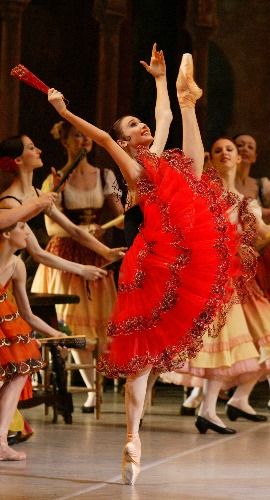 Opening night, Kitri was played by Svetlana Zakharova, the company’s most glittering star and a favorite with the local audience. She exemplifies the ballerina model that both the Kirov (her company of origin) and the Bolshoi now favor—tall, exceedingly long-limbed, frighteningly thin, with a tiny head, bowstring arches, and a hip joint so mobile it permits those eerie extensions in which the leg, flung straight up, permits the dancer’s knee to graze her cheek. All of this is thought to be beautiful.
Opening night, Kitri was played by Svetlana Zakharova, the company’s most glittering star and a favorite with the local audience. She exemplifies the ballerina model that both the Kirov (her company of origin) and the Bolshoi now favor—tall, exceedingly long-limbed, frighteningly thin, with a tiny head, bowstring arches, and a hip joint so mobile it permits those eerie extensions in which the leg, flung straight up, permits the dancer’s knee to graze her cheek. All of this is thought to be beautiful.
Zakharova is celebrated for her legato dancing, in which time seems to slow down as her body etches one infinitely graceful line after another on the air. As Kitri, a role better filled by a soubrette type, she goes out of her way to be extroverted and exuberant, proving several times over that, yes, she has mastered Maya Plisetskaya’s flamboyant trick of arching backward in full sail while tossing her leg up behind her to kick the back of her head. Zakharova is right on target here in going for vivacity and bravura feats, but the results have little spontaneity and even less joy.
I preferred Ekaterina Shipulina as Kitri. Her gifts are more modest than Zakharova’s and she lacks Zakharova’s appetite for glory, but her body is closer to the range of normal, and when she dances—even with all the show-off acrobatics and emphatic flourishes endemic to Bolshoi style—what she does looks like something a spirited young woman might really do if she were animated by love and dancing, It looks almost human.
Andrey Uvarov partnered both Zakharova and Shipulina at the performances I saw. He’s a genial presence and expert at ballerina handling in matters of multiple supported pirouettes and one-armed lifts. On his own, he’s notable for legs that work like rapiers on big leaps, like scissors in vertical jumps with beats. Gratifying as all this is, though, he’s not a star, and the role of Basilio (or Basil, as it’s been reduced to here) requires both megawatt charisma and, what’s more, a flair for comedy.
Not much energy was invested in making the mime a telling element in the proceedings. Still, the two leading all-mime roles were well cast to give us a tall, gaunt, Don Quixote (Alexey Loparevich), representing the life of the imagination and moral values, offset by a short, solid, jovial Sancho Panza (Alexander Petukhov), embodying the life of the belly and expediency. The rich fop, Gamache, was nicely observed, too—by Victor Alekhin—and Kitri’s mom, unessential to the plot, was nevertheless rendered deliciously by Evgenia Volochkova.
As for the corps work, only a killjoy could fail to get swept up in the vivacity of the village square scenes with their castanet clacking, fan fluttering, cape swirling crowd. At the opposite end of the spectrum, the sisterhood of dryads aimed appropriately at refined delicacy. But almost everyone, from top to bottom in the casting hierarchy, seemed to be doing nothing more than a conscientious job. Don Q takes its title from a character who’s a visionary, but this production is merely a showpiece in which vision would be a decidedly foreign object.
Photo: Damir Yuspov: Svetlana Zakharova as Kitri in the Bolshoi Ballet’s production of Don Quixote
© 2005 Tobi Tobias




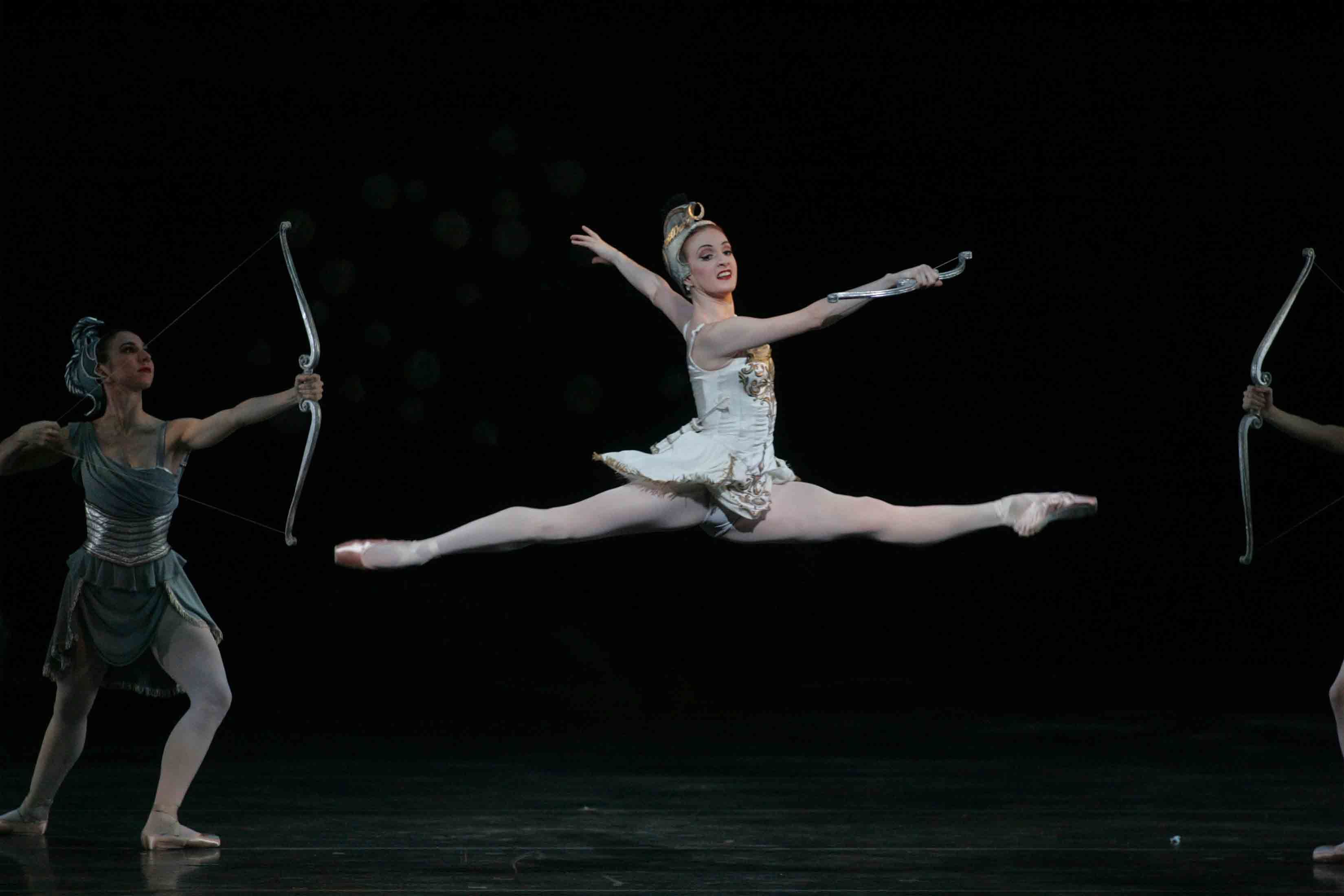
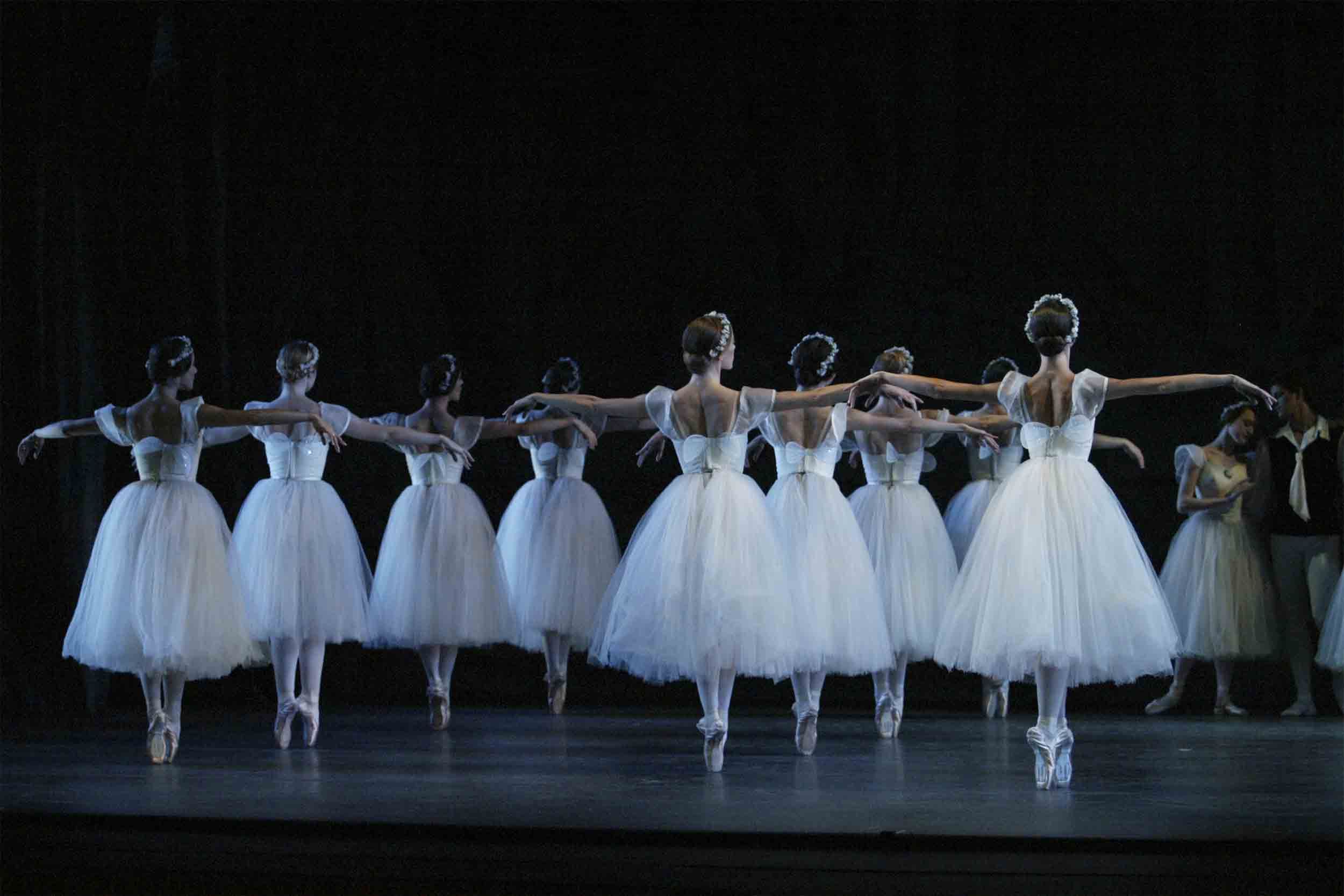 The ideal Les Sylphides, the Sylphides of my dreams—I’ve seen ravishing fragments of it over the years, most often at ABT—would look utterly spontaneous, a vision that arose on the spur of the moment. ABT’s current staging of the ballet, by Kirk Peterson, is one of those ventures that tries so hard to be stylistically correct—an achievement to be sure, but not essentially an aesthetic one—that it ends up devoid of breath. Suffocating under this demand for refinement, the dancing takes on a mausoleum quality. I wished the participants would have a rehearsal or two at which they danced the ballet straight through at a markedly swifter pace than the one the orchestra now assigns it, and another at which, instead of being instructed to parse the choreography, the dancers were urged to “just throw it away.”
The ideal Les Sylphides, the Sylphides of my dreams—I’ve seen ravishing fragments of it over the years, most often at ABT—would look utterly spontaneous, a vision that arose on the spur of the moment. ABT’s current staging of the ballet, by Kirk Peterson, is one of those ventures that tries so hard to be stylistically correct—an achievement to be sure, but not essentially an aesthetic one—that it ends up devoid of breath. Suffocating under this demand for refinement, the dancing takes on a mausoleum quality. I wished the participants would have a rehearsal or two at which they danced the ballet straight through at a markedly swifter pace than the one the orchestra now assigns it, and another at which, instead of being instructed to parse the choreography, the dancers were urged to “just throw it away.”
 After reveling in the extravagant light and space of the public areas, you’re shocked by the enclosed darkness of the auditorium. The contrast constitutes a theatrical coup in itself. The interior is paneled with a Japanese-style arrangement of slatted wood in two tones of brown—deep and deeper. The wood is pierced with little lights so that, once seated, you can actually read your program, but the room as a whole, with its balconies seeming to embrace the stage as you look towards it, instills a feeling of intimacy. In this it declares its cousinship with the Royal Theatre’s Old Stage.
After reveling in the extravagant light and space of the public areas, you’re shocked by the enclosed darkness of the auditorium. The contrast constitutes a theatrical coup in itself. The interior is paneled with a Japanese-style arrangement of slatted wood in two tones of brown—deep and deeper. The wood is pierced with little lights so that, once seated, you can actually read your program, but the room as a whole, with its balconies seeming to embrace the stage as you look towards it, instills a feeling of intimacy. In this it declares its cousinship with the Royal Theatre’s Old Stage.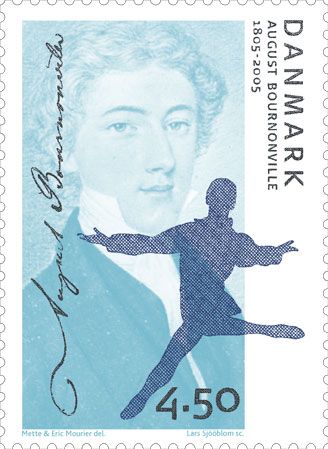

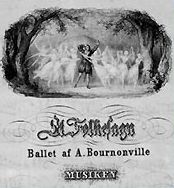
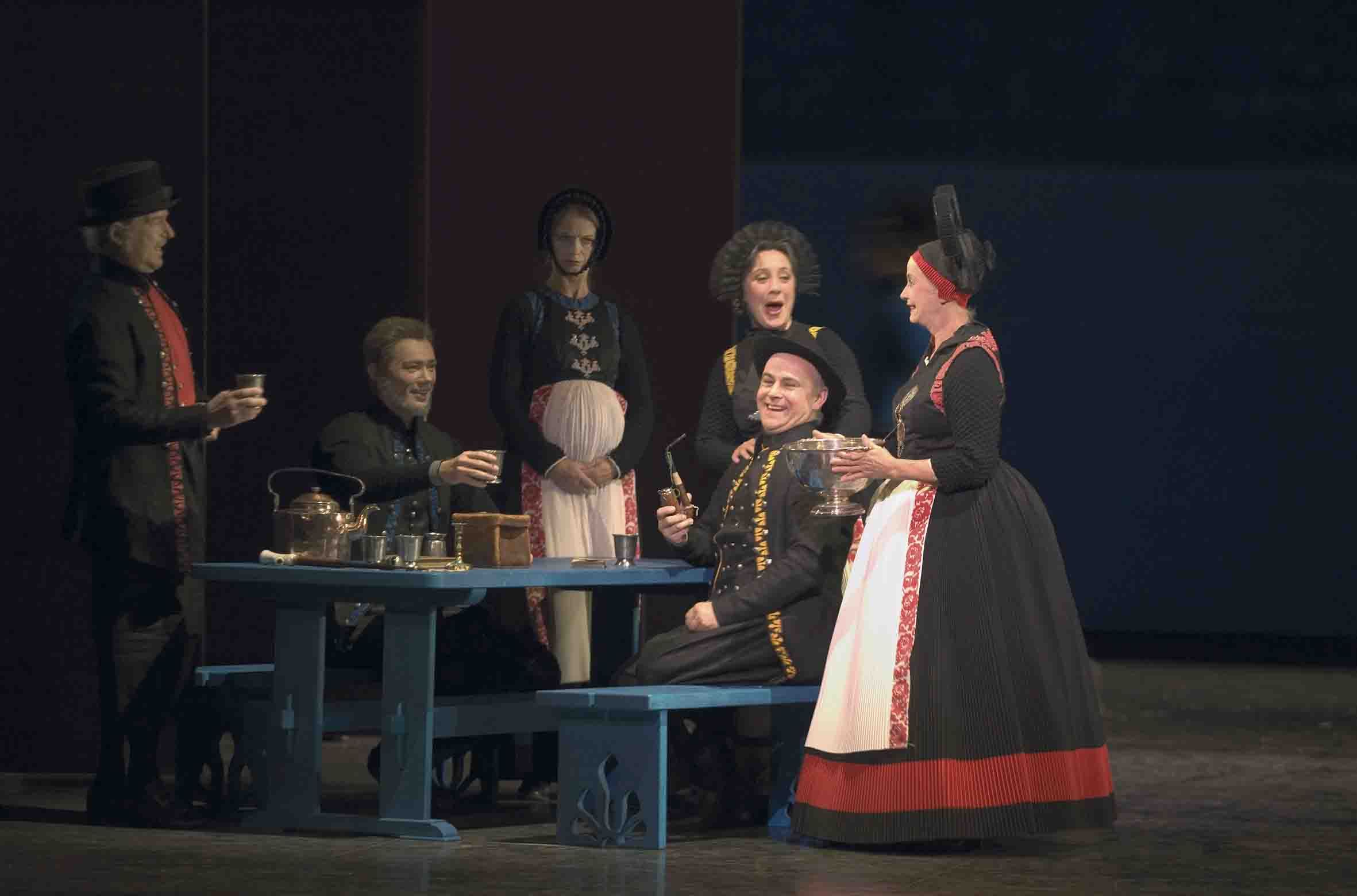
 Two of the most striking images in the display record a pair of haunting embraces from La Sylphide. One, from the 1966-67 season, shows the consummate danseur noble Henning Kronstam cradling the head of the dying Sylphide (Anna Lærkesen) as she falls back in his arms. His face is a mask of sheer poetry, summing up love, longing, and loss in a single sublime moment. In the other, from the 1979-80 season, Sorella Englund, as Madge, embraces Arne Villumsen’s half-fainting James from behind, inserting her face, all grinning malevolence, next to his as if she were some terrible twin to the beautiful man whose ruin she has helped Fate execute. Viewers may notice that both Kronstam’s and Englund’s hands echo what their faces express. This congruity—half instinctive, half consciously honed—is something to look for in a performing artist likely to go down in the history books.
Two of the most striking images in the display record a pair of haunting embraces from La Sylphide. One, from the 1966-67 season, shows the consummate danseur noble Henning Kronstam cradling the head of the dying Sylphide (Anna Lærkesen) as she falls back in his arms. His face is a mask of sheer poetry, summing up love, longing, and loss in a single sublime moment. In the other, from the 1979-80 season, Sorella Englund, as Madge, embraces Arne Villumsen’s half-fainting James from behind, inserting her face, all grinning malevolence, next to his as if she were some terrible twin to the beautiful man whose ruin she has helped Fate execute. Viewers may notice that both Kronstam’s and Englund’s hands echo what their faces express. This congruity—half instinctive, half consciously honed—is something to look for in a performing artist likely to go down in the history books.